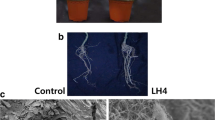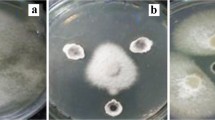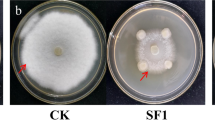Abstract
Phytophthora drechsleri damping-off is one of the most important diseases of cucumber (Cucumis sativus). Salinity is a serious problem for crop production and affects diversity and activity of soil microorganisms. Application of salt-tolerant biocontrol agents may be beneficial in order to protect plants against pathogenic fungi in saline soils. In this study, a total of 717 Streptomyces isolates were isolated from the rhizosphere of cucumber, out of which two isolates showed more than 70% inhibitory effect against P. drechsleri and had cellulase activity in the presence and absence of NaCl. In a greenhouse experiment, two Streptomyces isolates with the highest antagonistic activity, strains C 201 and C 801, reduced seedling damping-off of cucumber caused by P. drechsleri by 77 and 80%, respectively, in artificially infested soils. Strain C 201 increased dry weight of seedlings up to 21% in greenhouse experiments. Phylogenetic analyses of 16S rRNA gene sequence reveals that strains C 201 and C 801 are closely related to S. rimosus and S. monomycini respectively. Increased activity of polyphenol oxidase (PPO) and peroxidase (POX) enzymes in Streptomyces-treated plants proved the biocontrol-induced systemic resistance (ISR) in cucumber plants against P. drechsleri.






Similar content being viewed by others
References
Altschul SF, Madden TL, Schäffer AA, Zhang J, Zhang Z, Miller W, Lipman DJ (1997) Gapped BLAST and PSI-BLAST: a new generation of protein database search programs. Nucleic Acids Res 25:3389–3402
Basilio A, Gonzalez I, Vicente MF, Gorrochategui J, Cabello A, Gonzalez A, Genilloud O (2003) Patterns of antimicrobial activities from soil actinomycetes isolated under different conditions of pH and salinity. J Appl Microbiol 95:814–823
Berg G, Marten P, Minkwitz A, Brückner S, Lüth P (2001) Efficient biological control of fungal plant diseases by Streptomyces rimosus DSMZ 12424. Tri-trophic interactions in the rhizosphere. IOBC/WPRS Bull 24:9–14
Bhuiyan NH, Selvaraj G, Wei YD, King J (2009) Role of lignification in plant defense. Plant Signal Behav 4:158–159
Blanco FF, Folegatti MV (2002) Salt accumulation and distribution in a greenhouse soil as affected by salinity of irrigation water and leaching management. Rev Bras Eng Agríc Ambient 6:414–419
Bradford MM (1976) A rapid and sensitive method for the quantization of microgram quantities of protein utilizing the principle of protein-dye binding. Anal Biochem 72:248–254
Café-Filho AC, Ristaino JB (2008) Fitness of isolates of Phytophthora capsici resistant to mefenoxam from squash and pepper fields in North Carolina. Plant Dis 92:1439–1443
Chartzoulakis KS (1992) Effects of NaCl salinity on germination, growth and yield of greenhouse cucumber. J Hortic Sci 67:115–119
Chen C, Bélanger RR, Benhamou N, Paulitz TC (2000) Defense enzymes induced in cucumber roots by treatment with plant growth promoting rhizobacteria (PGPR) and Pythium aphanidermatum. Physiol Mol Plant Pathol 56:13–23
Chen L, Xin X, Yuan Q, Su D, Liu W (2014) Phytochemical properties and antioxidant capacities of various colored berries. J Sci Food Agric 94:180–188
Chun J, Goodfellow M (1995) A phylogenetic analysis of the genus Nocardia with 16S rRNA gene sequences. Int J Syst Evol Microbiol 45:240–245
Cominelli E, Conti L, Tonelli C, Galbiati M (2013) Challenges and perspectives to improve crop drought and salinity tolerance. N Biotechnol 30:355–361
Conn VM, Walker AR, Franco CM (2008) Endophytic Actinobacteria induce defense pathways in Arabidopsis thaliana. Mol Plant Microbe Interact 21:208–215
Davidson RN, den Boer M, Ritmeijer K (2009) Paromomycin. Trans R Soc Trop Med Hyg 103:653–660
Downer AJ, Menge JA, Pond E (2001) Association of cellulytic enzyme activities in Eucalyptus mulches with biological control of Phytophthora cinnamomi. Phytopathology 91:847–855
El-Tarabily KA, Nassar AH, Hardy GE, Sivasithamparam K (2009) Plant growth promotion and biological control of Pythium aphanidermatum, a pathogen of cucumber, by endophytic actinomycetes. J Appl Microbiol 106:13–26
Esterbauer H, Schwarzl E, Hayn M (1977) A rapid assay for catechol oxidase and laccase using 2-nitro-5-thiobenzoic acid. Anal Biochem 77:486–494
Fernando WG, Rajesh Ramarathnam D, Krishnamoorthy AS, Savchuk SC (2005) Identification and use of potential bacterial organic antifungal volatiles in biocontrol. Soil Biol Biochem 37:955–964
Goudjal Y, Toumatia O, Yekkour A, Sabaou N, Mathieu F, Zitouni A (2014) Biocontrol of Rhizoctonia solani damping-off and promotion of tomato plant growth by endophytic actinomycetes isolated from native plants of Algerian Sahara. Microbiol Res 169:59–65
Guyer A, De Vrieze M, Bönisch D, Gloor R, Musa T, Bodenhausen N, Bailly A, Weisskopf L (2015) The anti-Phytophthora effect of selected potato-associated Pseudomonas strains: from the laboratory to the field. Front Microbiol 6:1309
Hamdali H, Hafidi M, Virolle MJ, Ouhdouch Y (2008) Growth promotion and protection against damping-off of wheat by two rock phosphate solubilizing actinomycetes in a P-deficient soil under greenhouse conditions. Appl Soil Ecol 40:510–517
Han J, Shi J, Zeng L, Xu J, Wu L (2015) Effects of nitrogen fertilization on the acidity and salinity of greenhouse soils. Environ Sci Pollut Res Int 22:2976–2986
Hatami N, Aminaee MM, Zohdi H, Tanideh T (2013) Damping-off disease in greenhouse cucumber in Iran. Arch Phytopathol Plant Protect 46:796–802
Hwang BK, Lim SW, Kim BS, Lee JY, Moon SS (2001) Isolation and in vivo and in vitro antifungal activity of phenylacetic acid and sodium phenylacetate from Streptomyces humidus. Appl Environ Microbiol 67:3739–3745
Islam S, Akanda AM, Prova A, Islam MT, Hossain MM (2016) Isolation and identification of plant growth promoting rhizobacteria from cucumber rhizosphere and their effect on plant growth promotion and disease suppression. Front Microbiol 6:1360
Jose PA, Santhi VS, Jebakumar SRD (2011) Phylogenetic-affiliation, antimicrobial potential and PKS gene sequence analysis of moderately halophilic Streptomyces sp. inhabiting an Indian saltpan. J Basic Microbiol 51:348–356
Karimi E, Sadeghi A, Abaszadeh Dahaji P, Dalvand Y, Omidvari M, Kakuei Nezhad M (2012) Biocontrol activity of salt tolerant Streptomyces isolates against phytopathogens causing root rot of sugar beet. Biocontrol Sci Technol 22:333–349
Kavitha R, Umesha S (2008) Regulation of defense-related enzymes associated with bacterial spot resistance in tomato. Phytoparasitica 36:144–159
Khare E, Singh S, Maheshwari DK, Arora NK (2011) Suppression of charcoal rot of chickpea by fluorescent Pseudomonas under saline stress condition. Curr Microbiol 62:1548–1553
Kroon LPNM, Brouwer H, de Cock AWAM, Govers F (2012) The genus Phytophthora Anno 2012. Phytopathology 102:348–364
Kruijt M, Tran H, Raaijmakers JM (2009) Functional, genetic and chemical characterization of biosurfactants produced by plant growth-promoting Pseudomonas putida 267. J Appl Microbiol 107:546–556
Li X, Huang P, Wang Q, Xiao L, Liu M, Bolla K, Zhang B, Zheng L, Gan B, Liu X, Zhang L, Zhang X (2014) Staurosporine from the endophytic Streptomyces sp. strain CNS-42 acts as a potential biocontrol agent and growth elicitor in cucumber. Antonie van Leeuwenhoek 106:515–525
Loliam B, Morinaga T, Chaiyanan S (2012) Biocontrol of Phytophthora infestans, fungal pathogen of seedling damping-off disease in economic plant nursery. Psyche 2012: Article ID 324317
Lozovaya VV, Lygin AV, Li S, Hartman GL, Widholm JM (2004) Biochemical response of soybean roots to f. sp. Infection. Crop Sci 44:819–826
Macagnan D, Romeiro RS, Pomella AWV, deSouza JT (2008) Production of lytic enzymes and siderophores, and inhibition of germination of basidiospores of Moniliophthora (ex Crinipellis) perniciosa by phylloplane actinomycetes. Biol Control 47:309–314
Majidi S, Roayaei M, Ghezelbash G (2011) Carboxymethyl cellulase and filter paperase activity of new strains isolated from Persian Gulf. Microbiol J 1:8–16
Mayer AM (2006) Polyphenol oxidases in plants and fungi: going places? A review. Phytochemistry 67:2318–2331
Nazavari K, Jamali F, Bayat F, Modarresi M (2016) Evaluation of resistance to seedling damping-off caused by Phytophthora drechsleri in cucumber cultivars under greenhouse conditions. Biol Forum Int J 8:54–60
Nguyen XH, Naing KW, Lee YS, Tindwa H, Lee GH, Jeong BK, Ro HM, Kim SJ, Jung WJ, Kim KY (2012) Biocontrol Potential of Streptomyces griseus H7602 against root rot disease (Phytophthora capsici) in pepper. Plant Pathol J 28:282–289
Palaniyandi SA, Yang SH, Suh JW (2013) Extracellular proteases from Streptomyces phaeopurpureus ExPro138 inhibit spore adhesion, germination and appressorium formation in Colletotrichum coccodes. J Appl Microbiol 115:207–217
Putter J (1974) Peroxidases. In: Bergmeyer HU (ed) Methods of enzymatic analysis, vol 2. Verlag Chemie-Academic Press, New York, pp 685–690
Quecine MC, Araujo WL, Marcon J, Gai CS, Azevedo JL, Pizzirani-Kleiner AA (2008) Chitinolytic activity of endophytic Streptomyces and potential for biocontrol. Lett Appl Microbiol 47:486–491
Raj SN, Sarosh BR, Shetty HS (2006) Induction and accumulation of polyphenol oxidase activities as implicated in development of resistance against pearl millet downy mildew disease. Funct Plant Biol 33:563–571
Rangarajan S, Saleena LM, Vasudevan P, Nair S (2003) Biological suppression of rice diseases by Pseudomonas spp. under saline soil conditions. Plant Soil 251:73–82
Sabaratnam S, Traquair JA (2002) Formulation of a Streptomyces biocontrol agent for the suppression of Rhizoctonia damping-off in tomato transplants. Biol Control 23:245–253
Sadeghi A, Soltani BM, Salehi Jouzani G, Karimi E, Khayam Nekouei M, Sadeghizadeh M (2014) Taxonomic study of a salt tolerant Streptomyces sp. strain C-2012 and the effect of salt and ectoine on lon expression level. Microbiol Res 169:232–238
Salla TD, Astarita LV, Santarém ER (2016) Defense responses in plants of Eucalyptus elicited by Streptomyces and challenged with Botrytis cinerea. Planta 243:1055–1070
Sang MK, Chun SC, Kim KD (2008) Biological control of Phytophthora blight of pepper by antagonistic rhizobacteria selected from a sequential screening procedure. Biol Control 46:424–433
Seo DJ, Nguyen DM, Song YS, Jung WJ (2012) Induction of defense response against Rhizoctonia solani in cucumber plants by endophytic bacterium Bacillus thuringiensis GS1. J Microbiol Biotechnol 22:407–415
Shih HD, Liu YC, Hsu FL, Mulabagal V, Dodda R, Huang JW (2003) Fungichromin: a substance from Streptomyces padanus with inhibitory effects on Rhizoctonia solani. J Agric Food Chem 51:95–99
Shirzad A, Fallahzadeh-Mamaghani V, Pazhouhandeh M (2012) Antagonistic potential of fluorescent pseudomonads and control of crown and root rot of cucumber caused by Phythophtora drechsleri. Plant Pathol J 28:1–9
Singleton VL, Orthofer R, Lamuela-Raventos RM (1999) Analysis of total phenols and other oxidation substrates and antioxidants by means of Folin-Ciocalteu reagent. Methods Enzymol 299:152–178
Sonneveld C, Voogt SJ (1978) Effects of saline irrigation water on glasshouse cucumbers. Plant Soil 49:595–606
Spadaro D, Gullino ML (2005) Improving the efficacy of biocontrol agents against soilborne pathogens. Crop Prot 24:601–613
Tamura K, Peterson D, Peterson N, Stecher G, Nei M, Kumar S (2011) MEGA5: molecular evolutionary genetics analysis using maximum likelihood, evolutionary distance, and maximum parsimony methods. Mol Biol Evol 28:2731–2739
Taniguchi T, Imada S, Acharya K, Iwanaga F, Yamanaka N (2015) Effect of soil salinity and nutrient levels on the community structure of the root-associated bacteria of the facultative halophyte, Tamarix ramosissima, in southwestern United States. J Gen Appl Microbiol 61:193–202
Thipyapong P, Steffens JC (1997) Tomato polyphenol oxidase. Differential response of the polyphenol oxidase F promoter to injuries and wound signals. Plant Physiol 115:409–418
Treutter D (2006) Significance of flavonoids in plant resistance: a review. Environ Chem Lett 4:147–157
Tripathi G, Rawal SK (1998) A simple and efficient protocol for isolation of high molecular weight DNA from Streptomyces aureofaciens. Biotechnol Tech 12:629–631
Uppalapati SR, Marek SM, Lee HK, Nakashima J, Tang Y, Sledge MK, Dixon RA, Mysore KS (2009) Global gene expression profiling during Medicago truncatula-Phymatotrichopsis omnivora interaction reveals a role for jasmonic acid, ethylene, and the flavonoid pathway in disease development. Mol Plant Microbe Interact 22:7–17
Verma VC, Singh SK, Prakash S (2011) Biocontrol and plant growth promotion potential of siderophore producing endophytic Streptomyces from Azadirachta indica A. Juss. J Basic Microbiol 51:550–556
Viaene T, Langendries S, Beirinckx S, Maes M, Goormachtig S (2016) Streptomyces as a plant’s best friend? FEMS Microbiol Ecol 92:fiw119
Wan MG, Li GQ, Zhang JB, Jiang DH, Huang HC (2008) Effect of volatile substances of Streptomyces platensis F-1 on control of plant fungal diseases. Biol Control 46:552–559
Wang C, Wang Z, Qiao X, Li Z, Li F, Chen M, Wang Y, Huang Y, Cui H (2013) Antifungal activity of volatile organic compounds from Streptomyces alboflavus TD-1. FEMS Microbiol Lett 341:45–51
Weselowski B, Nathoo N, Eastman AW, MacDonald J, Yuan ZC (2016) Isolation, identification and characterization of Paenibacillus polymyxa CR1 with potentials for biopesticide, biofertilization, biomass degradation and biofuel production. BMC Microbiol 16:244
Widmer TL, Guermache F (2004) Filtrates of rhizosphere bacteria suppressive to Centaurea solstitialis seed germination. J Plant Dis Protect 19:497–502
Xiao K, Kinkel LL, Samac DA (2002) Biological control of Phytophthora root rot on alfalfa and soybean with Streptomyces. Biol Control 23:285–295
Xu L, Zhu L, Tu L, Liu L, Yuan D, Jin L, Long L, Zhang X (2011) Lignin metabolism has a central role in the resistance of cotton to the wilt fungus Verticillium dahliae as revealed by RNA-Seq-dependent transcriptional analysis and histochemistry. J Exp Bot 62:5607–5621
Yang MM, Xu LP, Xue QY, Yang JH, Xu Q, Liu HX, Guo JH (2012) Screening potential bacterial biocontrol agents towards Phytophthora capsici in pepper. Eur J Plant Pathol 134:811–820
Yekkour A, Sabaou N, Zitouni A, Errakhi R, Mathieu F, Lebrihi A (2012) Characterization and antagonistic properties of Streptomyces strains isolated from Saharan soils and evaluation of their ability to control seedling blight of barley caused by Fusarium culmorum. Lett Appl Microbiol 55:427–435
Yuan WM, Crawford DL (1995) Characterization of Streptomyces lydicus WYEC108 as a potential biocontrol agent against fungal root and Seed rots. Appl Environ Microbiol 61:3119–3128
Zarafeta D, Kissas D, Saye C, Gudbergsdottir SR, Ladoukakis E, Isupov MN, Chatziioannou A, Peng X, Littlechild JA, Skretas G, Kolisis FN (2016) Discovery and characterization of a thermostable and highly halotolerant GH5 cellulase from an icelandic hot spring isolate. PLoS ONE 11(1):e0146454
Zhao S, Du CM, Tian CY (2012) Suppression of Fusarium oxysporum and induced resistance of plants involved in the biocontrol of cucumber Fusarium wilt by Streptomyces bikiniensis HD-087. World J Microbiol Biotechnol 28:2919–2927
Acknowledgements
The authors are grateful to the Agricultural Biotechnology Research Institute of Iran (ABRII), for financial support of this Project (Project No:01-05-05-9454).
Author information
Authors and Affiliations
Corresponding author
Ethics declarations
Conflict of interest
Authors declare that there exists no conflict of interest among them.
Additional information
Handling Editor: Jane Debode.
Rights and permissions
About this article
Cite this article
Sadeghi, A., Koobaz, P., Azimi, H. et al. Plant growth promotion and suppression of Phytophthora drechsleri damping-off in cucumber by cellulase-producing Streptomyces . BioControl 62, 805–819 (2017). https://doi.org/10.1007/s10526-017-9838-4
Received:
Accepted:
Published:
Issue Date:
DOI: https://doi.org/10.1007/s10526-017-9838-4




